The Role of BIA Analysis in Osteoporosis Risk Development: Hierarchical Clustering Approach
Abstract
:1. Introduction
2. Materials and Methods
2.1. Participants
2.2. Exclusion Criteria
2.3. Anthropometric Measurements
2.4. Analysis of Body Composition
2.5. Hierarchical Clustering Algorithm: Clustering for Prototype Patients’ Recognition
2.5.1. Dataset Preparation
2.5.2. Dataset Clustering
2.5.3. Dendrogram Analysis and Cutting
- Automatic Rule:
- (A)
- Compute intra- and inter-cluster variability
- (B)
- Maximum intra-cluster and minimal inter-cluster variabilities are defined as follows:
- (C)
- index represents the ratio between the minimal inter-cluster variability and the maximum intra-cluster variability obtained during one iteration in which two clusters are merged. It is computed as follows:
- (D)
- Tree cutting: it is the operation of cutting the dendrogram at the point corresponding to the optimal clusterization, i.e., the number of cluster where the Rk value is maximum (Figure 5). Using various combinations of distance-linkage criteria, we obtained numerous potential clusterization outcomes (as shown in Table 3), each with the potential for physiological interpretation. Considering the labor-intensive nature of physiological interpretation, we have chosen to narrow down our analysis to the most frequently observed pattern of clusterization. Specifically, we will focus on the metric-linkage combinations referred to as “2 Clusters (Clustering 1)” in Table 3. We obtained at least one interesting outcome for each combination of distance-linkage criterion. In order to physiologically interpret each of these results, we will limit our analysis to the metric-linkage combinations corresponding to: 2 Clusters (Clustering 1) of Table 3. Such a result consists of the maximum corresponding Rk value in a two group clusterization. As we will show in the next paragraph, two dishomogeneous clusters were found: one composed by two elements, and the other one by the remaining elements.
2.5.4. Patient Prototypes (Principal States) Extraction
3. Results
3.1. Physiological Interpretation
3.2. Potential Use of Clustering Results
4. Discussion
5. Conclusions
Author Contributions
Funding
Institutional Review Board Statement
Informed Consent Statement
Data Availability Statement
Acknowledgments
Conflicts of Interest
References
- Ono, Y.; Kasukawa, Y.; Sasaki, K.; Miyakoshi, N. Association of the bioimpedance phase angle and quality of life in postmenopausal osteoporosis. Med. Princ. Pract. 2022, 32, 71–76. [Google Scholar] [CrossRef]
- Martin, A.R.; Sornay-Rendu, E.; Chandler, J.M.; Duboeuf, F.; Girman, C.J.; Delmas, P.D. The impact of osteoporosis on quality-of-life: The OFELY cohort. Bone 2002, 1, 32–36. [Google Scholar] [CrossRef]
- Masunari, N.; Fujiwara, S.; Nakata, Y.; Nakashima, E.; Nakamura, T. Historical height loss, vertebral deformity, and health-related quality of life in Hiroshima cohort study. Osteoporos. Int. 2007, 18, 1493–1499. [Google Scholar] [CrossRef]
- Hagino, H.; Furukawa, K.; Fujiwara, S.; Okano, T.; Katagiri, H.; Yamamoto, K.; Teshima, R. Recent trends in the incidence and lifetime risk of hip fracture in Tottori, Japan. Osteoporos. Int. 2009, 20, 543–548. [Google Scholar] [CrossRef]
- Moon, J.J.; Park, S.G.; Ryu, S.M.; Park, C.H. New skeletal muscle mass index in diagnosis of sarcopenia. J. Bone Metab. 2018, 25, 15–21. [Google Scholar] [CrossRef] [Green Version]
- Fighera, T.M.; Santos, B.R.; Motta, L.; Casanova, G.; Spritzer, P.M. Associations between bone mass, hormone levels, and body composition in postmenopausal women. Menopause 2023, 30, 317–322. [Google Scholar] [CrossRef]
- Marra, M.; Sammarco, R.; De Lorenzo, A.; Iellamo, F.; Siervo, M.; Pietrobelli, A.; Donini, L.M.; Santarpia, L.; Cataldi, M.; Pasanisi, F.; et al. Assessment of Body Composition in Health and Disease Using Bioelectrical Impedance Analysis (BIA) and Dual Energy X-ray Absorptiometry (DXA): A Critical Overview. Contrast Media Mol. Imaging 2019, 2019, 3548284. [Google Scholar] [CrossRef]
- Al Hayek, S.; Matar Bou Mosleh, J.; Ghadieh, R.; El Hayek Fares, J. Vitamin D status and body composition: A cross-sectional study among employees at a private university in Lebanon. BMC Nutr. 2018, 4, 31. [Google Scholar] [CrossRef] [Green Version]
- Vanlint, S. Vitamin D and obesity. Nutrients 2013, 5, 949–956. [Google Scholar] [CrossRef] [Green Version]
- Dahbani, K.; Tsulidis, K.K.; Murphy, N.; Ward, H.A.; Bliott, P.; Riboli, E.; Gunter, M.; Tzoulaki, I. Prevalence of vitamin D deficiency and association with metabolic syndrome in Qatari population. Nutr. Diabetes 2017, 7, e263. [Google Scholar]
- Sadiya, A.; Ahmed, A.; Skaria, S.; Abusnana, S. Vitamin D status and itsrelationship with metabolic markers in persons with obesity and type 2diabetes in the UAE: A cross-sectional study. J. Diabetes Res. 2014, 2014, 869307. [Google Scholar] [CrossRef] [PubMed]
- Vranić, L.; Mikolaševic, I.; Milić, S. Vitamin D Deficiency: Consequence or Cause of Obesity? Medicina 2019, 55, 541. [Google Scholar] [CrossRef] [PubMed] [Green Version]
- Bray, G.A.; Kim, K.K.; Wilding, J.P.H. On behalf of the World Obesity Federation: Obesity: A chronic relapsing progressive disease process. A position statement of the world obesity federation. Obes. Rev. 2017, 18, 715–723. [Google Scholar] [CrossRef] [PubMed] [Green Version]
- World Health Organization. Joint WHO/FAO Expert Consultation: Diet, Nutrition, and the Prevention of Chronic Diseases; WHO Technical Report Series; World Health Organization: Geneva, Switzerland, 2003; pp. 916–1149. [Google Scholar]
- Valenzano, A.; Polito, R.; Trimigno, V.; Di Palma, A.; Moscatelli, F.; Corso, G.; Sessa, F.; Salerno, M.; Montana, A.; Di Nunno, N.; et al. Effects of very low-calorie ketogenic diet on the orexinergic system, visceral adipose tissue, and ros production. Antioxidants 2019, 8, 643. [Google Scholar] [CrossRef] [PubMed] [Green Version]
- Pickhardt, P.J.; Correale, L.; Hassan, C. AI-based opportunistic CT screening of incidental cardiovascular disease, osteoporosis, and sarcopenia: Cost-effectiveness analysis. Abdom. Radiol. 2023, 48, 1181–1198. [Google Scholar] [CrossRef]
- Peppa, M.; Stefanaki, C.; Papaefstathiou, A.; Boschiero, D.; Dimitriadis, G.; Chrousos, G.P. Bioimpedance analysis vs. DEXA as a screening tool for osteosarcopenia in lean, overweight and obese Caucasian postmenopausal females. Hormones 2017, 16, 181–193. [Google Scholar]
- Danilov, A.; Kramarenko, V.; Yurova, A. Modeling and analysis of bioimpedance measurements. In Abdominal Imaging. Computational and Clinical Applications; Yoshida, H., Näppi, J.J., Saini, S., Eds.; Springer: Cham, Switzerland, 2014; pp. 287–294. [Google Scholar]
- Lan, K.; Wang, D.T.; Fong, S.; Liu, L.S.; Wong, K.K.; Dey, N. A survey of data mining and deep learning in bioinformatics. J. Med. Syst. 2018, 42, 139. [Google Scholar] [CrossRef]
- Rosati, S.; Agostini, V.; Knaflitz, M.; Balestra, G. Muscle activation patterns during gait: A hierarchical clustering analysis. Biomed. Signal Process. Control 2017, 31, 463–469. [Google Scholar] [CrossRef] [Green Version]
- Tzanakou, E.M. (Ed.) Supervised and Unsupervised Pattern Recognition: Feature Extraction and Computational Intelligence; CRC Press: Boca Raton, FL, USA, 2017. [Google Scholar]
- Malik, O.A.; Senanayake, S.A.; Zaheer, D. An intelligent recovery progress evaluation system for acl reconstructed subjects using integrated 3-d kinematics and emg features. IEEE J. Biomed. Health Inform. 2014, 19, 453–463. [Google Scholar] [CrossRef]
- Faisal, T.; Taib, M.N.; Ibrahim, F. Adaptive neuro-fuzzy inference system for diagnosis risk in dengue patients. Expert Syst. Appl. 2012, 39, 4483–4495. [Google Scholar] [CrossRef]
- Roux, M. A comparative study of divisive and agglomerative hierarchical clustering algorithms. J. Classif. 2018, 35, 345–366. [Google Scholar] [CrossRef] [Green Version]
- Solo, V. Pearson distance is not a distance. arXiv 2019, arXiv:1908.06029. [Google Scholar]
- Nielsen, F.; Nielsen, F. Hierarchical clustering. In Introduction to HPC with MPI for Data Science; Springer: Berlin/Heidelberg, Germany, 2016; pp. 195–211. [Google Scholar]
- Murtagh, F.; Contreras, P. Algorithms for hierarchical clustering: An overview, II. Wiley Interdiscip. Rev. Data Min. Knowl. Discov. 2017, 7, e1219. [Google Scholar] [CrossRef] [Green Version]
- SCOOP-VLCD Task 7.3 Reports on Tasks for Scientific Cooperation. Collection of data on products intended for use in very-low calorie-diets. In Proceedings of the Report Brussels European Commission, Brussels, Belgium, 20 September 2002.
- Murtagh, F.; Contreras, P. Algorithms for hierarchical clustering: An overview. Wiley Interdiscip. Rev. Data Min. Knowl. Discov. 2012, 2, 86–97. [Google Scholar] [CrossRef]
- Fernández, A.; García, S.; Galar, M.; Prati, R.C.; Krawczyk, B.; Herrera, F. Learning from Imbalanced Data Sets; Springer: Cham, Switzerland, 2018; Volume 10, pp. 973–978. [Google Scholar]
- Nagi, R.; Tripathy, S.S. Application of fuzzy logic in plant disease management. In Fuzzy Expert Systems and Applications in Agricultural Diagnosis; IGI Global: Hershey, Pennsylvania, 2020; pp. 261–302. [Google Scholar]
- Kubler, S.; Robert, J.; Derigent, W.; Voisin, A.; Le Traon, Y. A state-of the-art survey & testbed of fuzzy AHP (FAHP) applications. Expert Syst. Appl. 2016, 65, 398–422. [Google Scholar]
- Ferrarin, M.; Bovi, G.; Rabuffetti, M.; Mazzoleni, P.; Montesano, A.; Pagliano, E.; Marchi, A.; Magro, A.; Marchesi, C.; Pareyson, D.; et al. Gait pattern classification in children with charcot–marie–tooth disease type 1a. Gait Posture 2012, 35, 131–137. [Google Scholar] [CrossRef] [Green Version]
- Ames, C.P.; Smith, J.S.; Pellisé, F.; Kelly, M.; Alanay, A.; Acaroglu, E.; Perez-Grueso, F.J.S.; Kleinstuck, F.; Obeid, I.; International Spine Study Group; et al. Artificial intelligence based hierarchical clustering of patient types and intervention categories in adult spinal deformity surgery: Towards a new classification scheme that predicts quality and value. Spine 2019, 44, 915–926. [Google Scholar] [CrossRef]
- Kawai, M.; de Paula, F.J.; Rosen, C.J. New insights into osteoporosis: The bone–fat connection. J. Int. Med. 2012, 272, 317–329. [Google Scholar] [CrossRef] [Green Version]
- Polito, R.; Nigro, E.; Messina, A.; Monaco, M.L.; Monda, V.; Scudiero, O.; Cibelli, G.; Valenzano, A.; Picciocchi, E.; Zammit, C.; et al. Adiponectin and orexin-a as a potential immunity link between adipose tissue and central nervous system. Front. Physiol. 2018, 9, 982. [Google Scholar] [CrossRef] [Green Version]
- Rodrıguez, J.P.; Montecinos, L.; Ríos, S.; Reyes, P.; Martínez, J. Mesenchymal stem cells from osteoporotic patients produce a type I collagen-deficient extracellular matrix favoring adipogenic differentiation. J. Cell. Biochem. 2000, 79, 557–565. [Google Scholar] [CrossRef]
- Li, Y.; Huang, Z.; Gong, Y.; Zheng, Y.; Zeng, Q. Retrospective analysis of the relationship between bone mineral density and body composition in a health check-up Chinese population. Front. Endocrinol. 2022, 13, 965758. [Google Scholar] [CrossRef]
- González, L.; Ramos-Trautmann, G.; Díaz-Luquis, G.M.; Pérez, C.M.; Palacios, C. Vitamin D status is inversely associated with obesity in a clinic-basedsample in Puerto Rico. Nutr. Res. 2015, 35, 287–293. [Google Scholar] [CrossRef] [PubMed] [Green Version]
- Osei, K. 25-OH vitamin D: Is it the universal panacea for metabolic syndromeand type 2 diabetes? J. Clin. Endocrinol. Metab. 2010, 95, 4220–4222. [Google Scholar] [CrossRef] [PubMed] [Green Version]
- Cai, Z.; Yang, Y.; Fu, X.; Mao, L.; Qiu, Y. Predictive value of body composition parameters for postoperative complications in patients received pancreaticoduodenectomy. Eur. Surg. Res. Eur. Chir. Forsch. Rech. Chir. Eur. 2023, 64, 252–260. [Google Scholar] [CrossRef]
- Bosy-Westphal, A.; Müller, M.J. Identification of skeletal mus-cle mass depletion across age and BMI groups in health anddisease—There is need for a unified definition. Int. J. Obes. 2015, 39, 379–386. [Google Scholar] [CrossRef]
- Blundell, J.E.; Dulloo, A.G.; Salvador, J.; Frühbeck, G. EASO SABWorking Group on BMI Beyond BMI-phenotyping the obesities. Obes. Facts 2014, 7, 322–328. [Google Scholar] [CrossRef]
- Decazes, P.; Ammari, S.; De Prévia, A.; Mottay, L.; Lawrance, L.; Belkouchi, Y.; Benatsou, B.; Albiges, L.; Balleyguier, C.; Vera, P.; et al. Body Composition to Define Prognosis of Cancers Treated by Anti-Angiogenic Drugs. Diagnostics 2023, 13, 205. [Google Scholar] [CrossRef]
- Sheu, A.; Greenfield, J.R.; White, C.P.; Center, J.R. Contributors to impaired bone health in type 2 diabetes. Trends Endocrinol. Metab. TEM 2023, 34, 34–48. [Google Scholar] [CrossRef]
- Grygiel-Górniak, B.; Puszczewicz, M. A review on irisin, a new protagonist that mediates muscle-adipose-bone-neuron connectivity. Eur. Rev. Med. Pharmacol. Sci. 2017, 21, 4687–4693. [Google Scholar]
- Kirk, B.; Feehan, J.; Lombardi, G.; Duque, G. Muscle, bone, and fat crosstalk: The biological role of myokines, osteokines, and adipokines. Curr. Osteoporos. Rep. 2020, 18, 388–400. [Google Scholar] [CrossRef]
- Giardullo, L.; Corrado, A.; Maruotti, N.; Cici, D.; Mansueto, N.; Cantatore, F.P. Adipokine role in physiopathology of inflammatory and degenerative musculoskeletal diseases. Int. J. Immunopathol. Pharmacol. 2021, 35, 20587384211015034. [Google Scholar] [CrossRef]

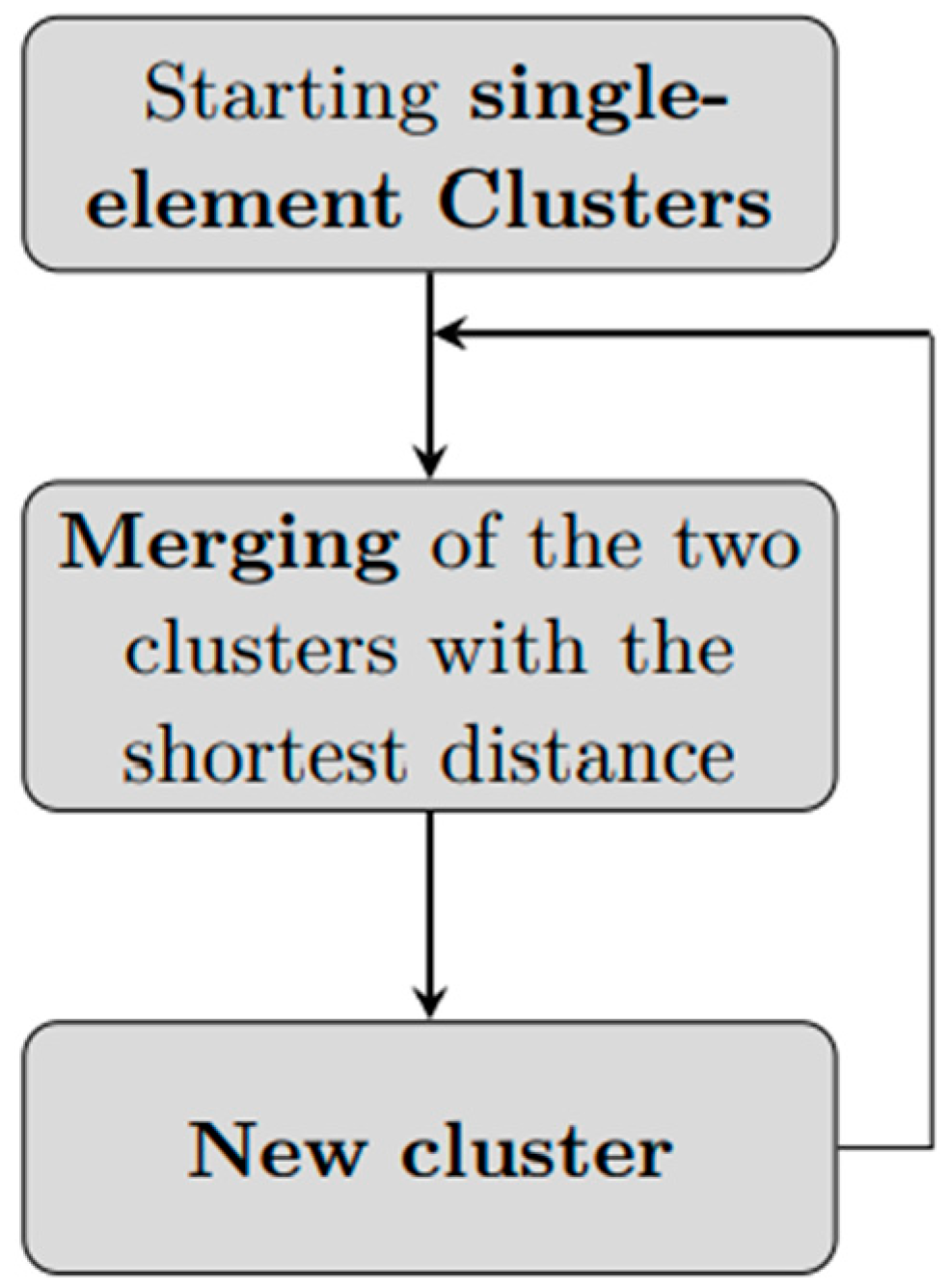
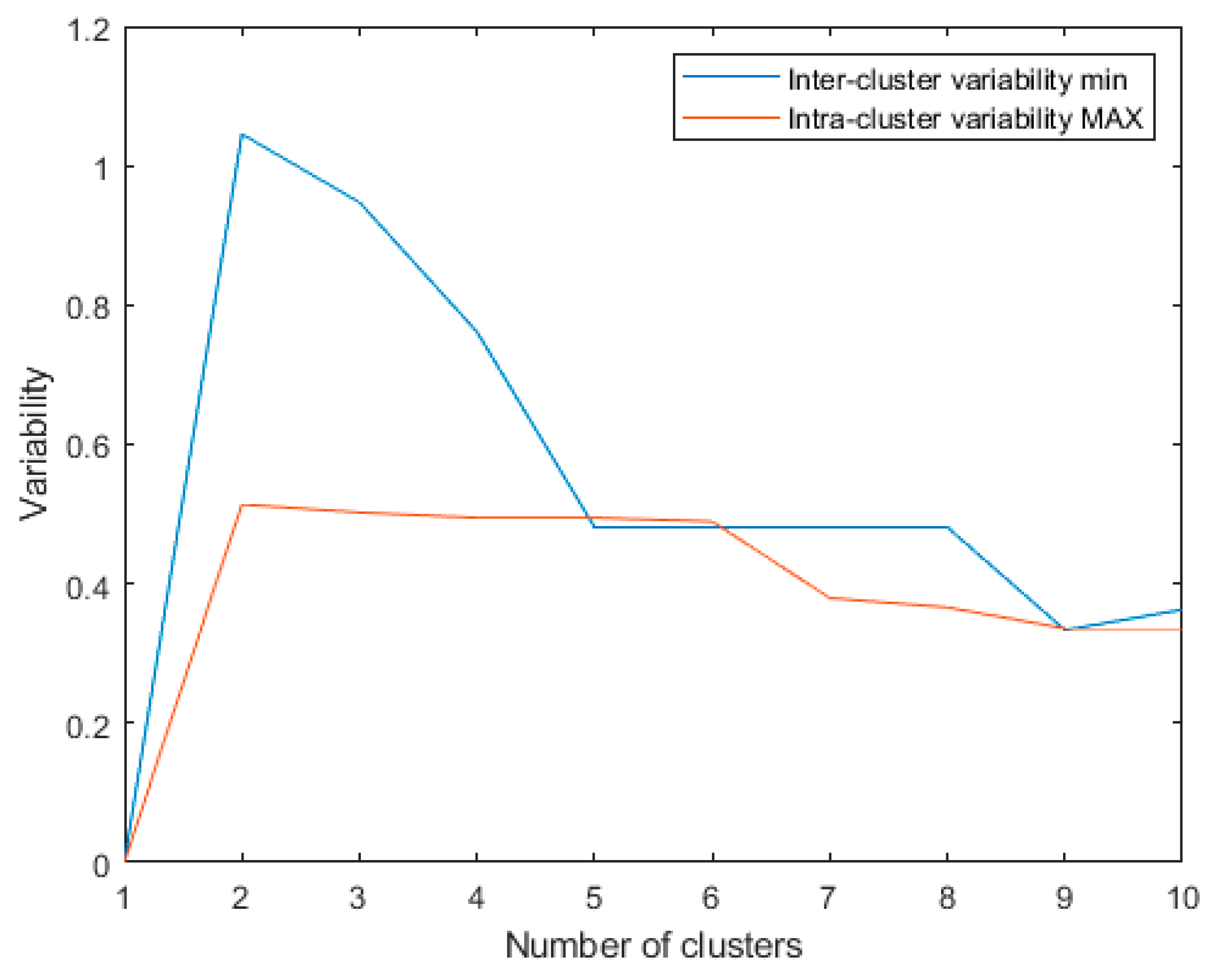

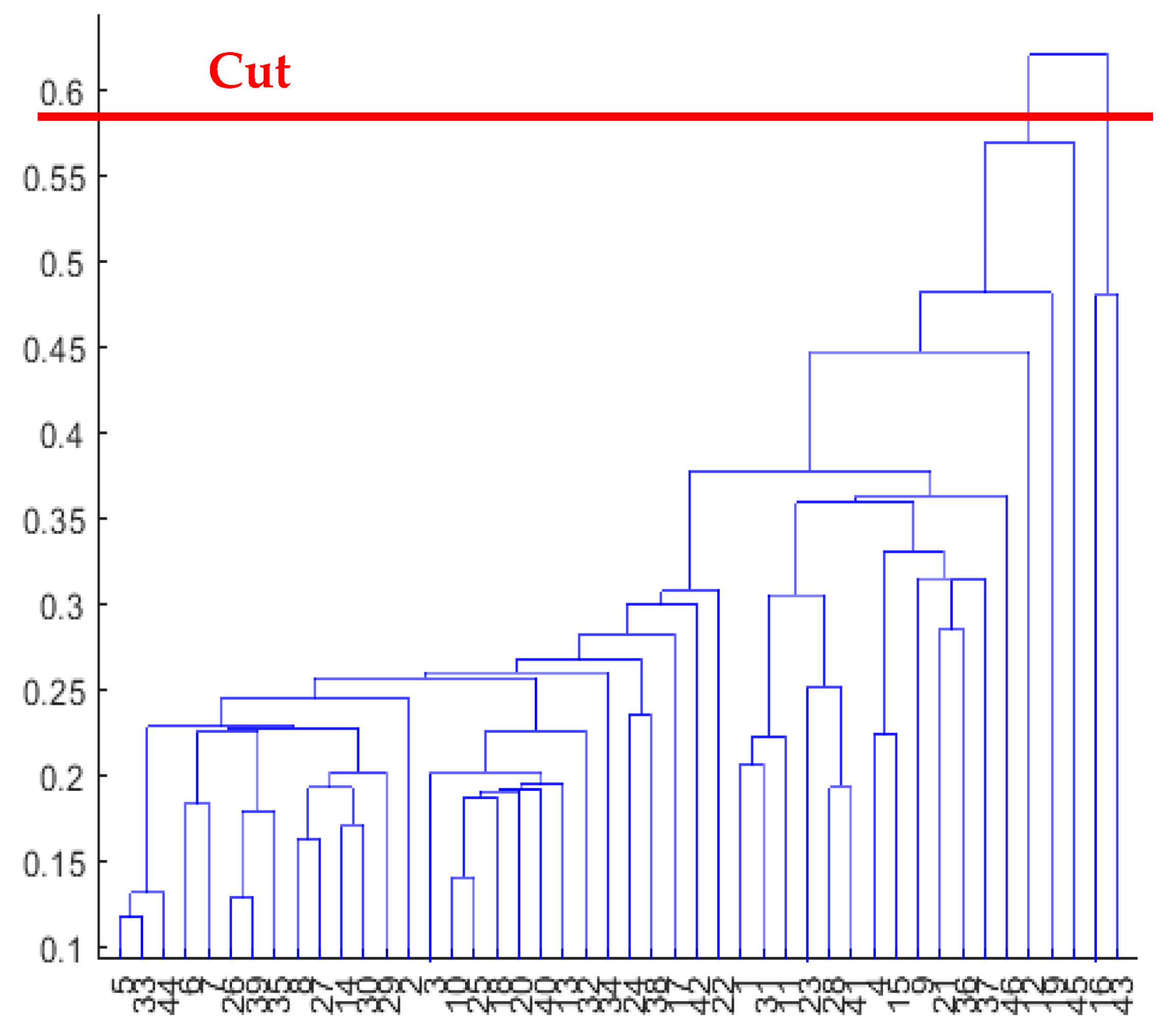
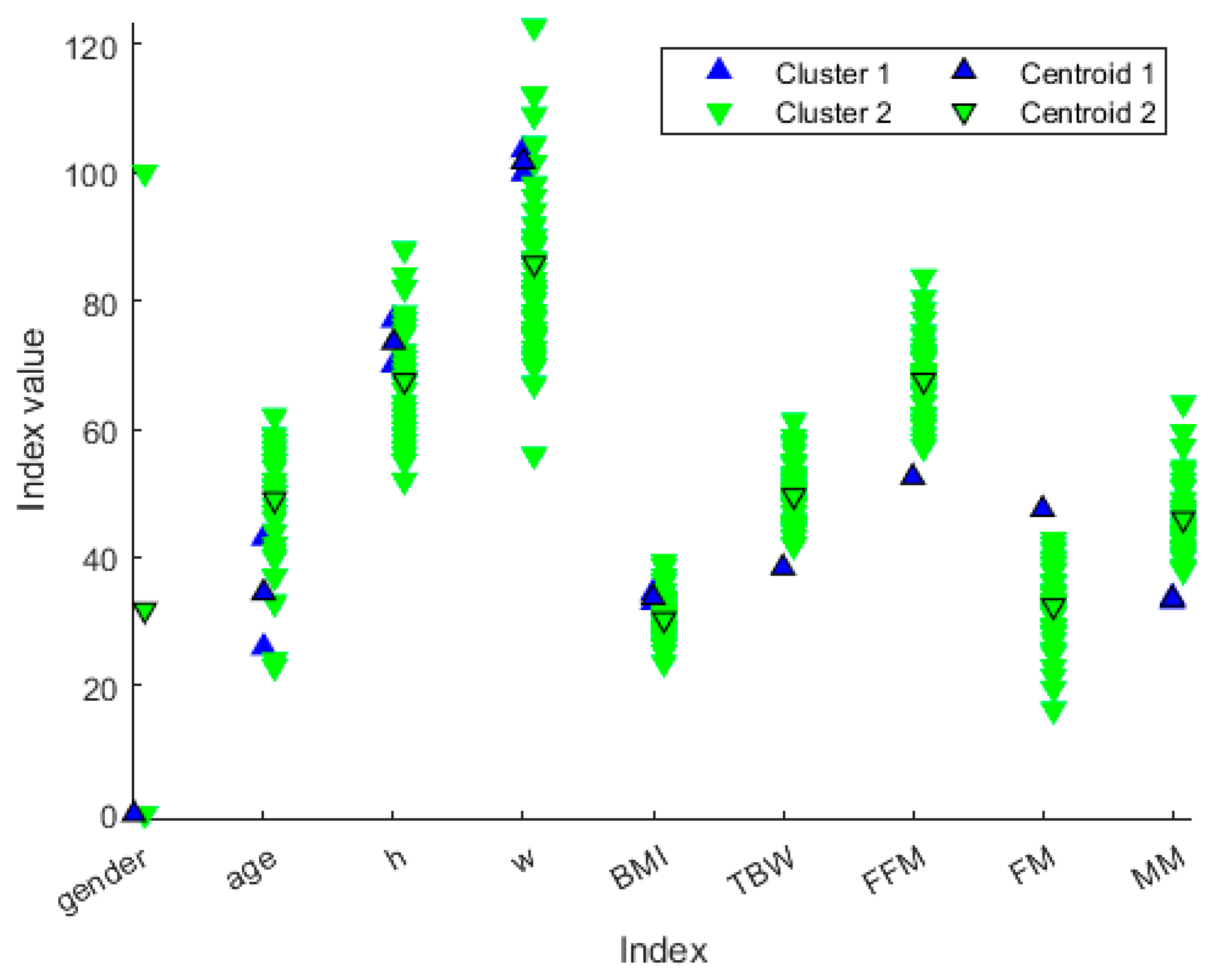
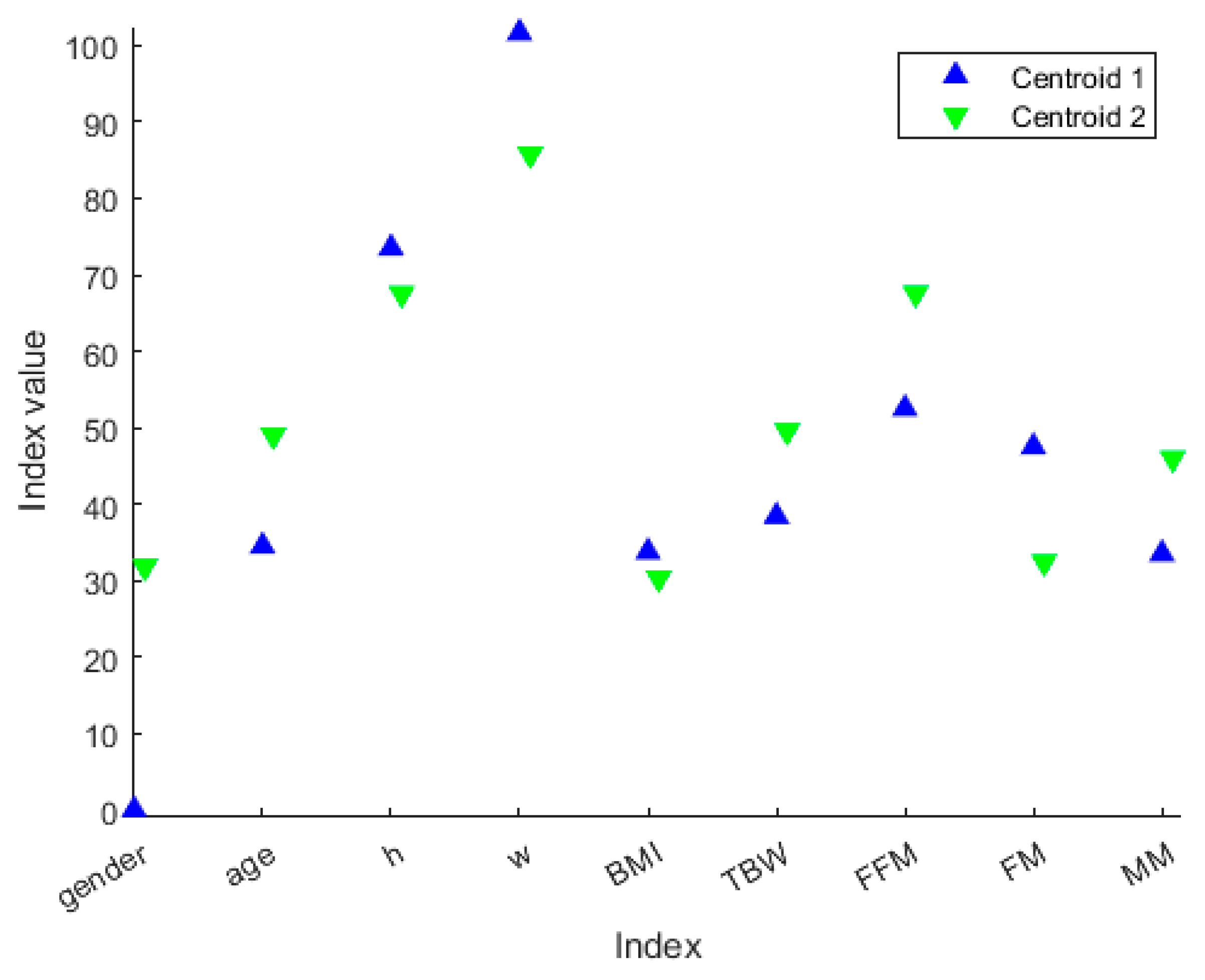
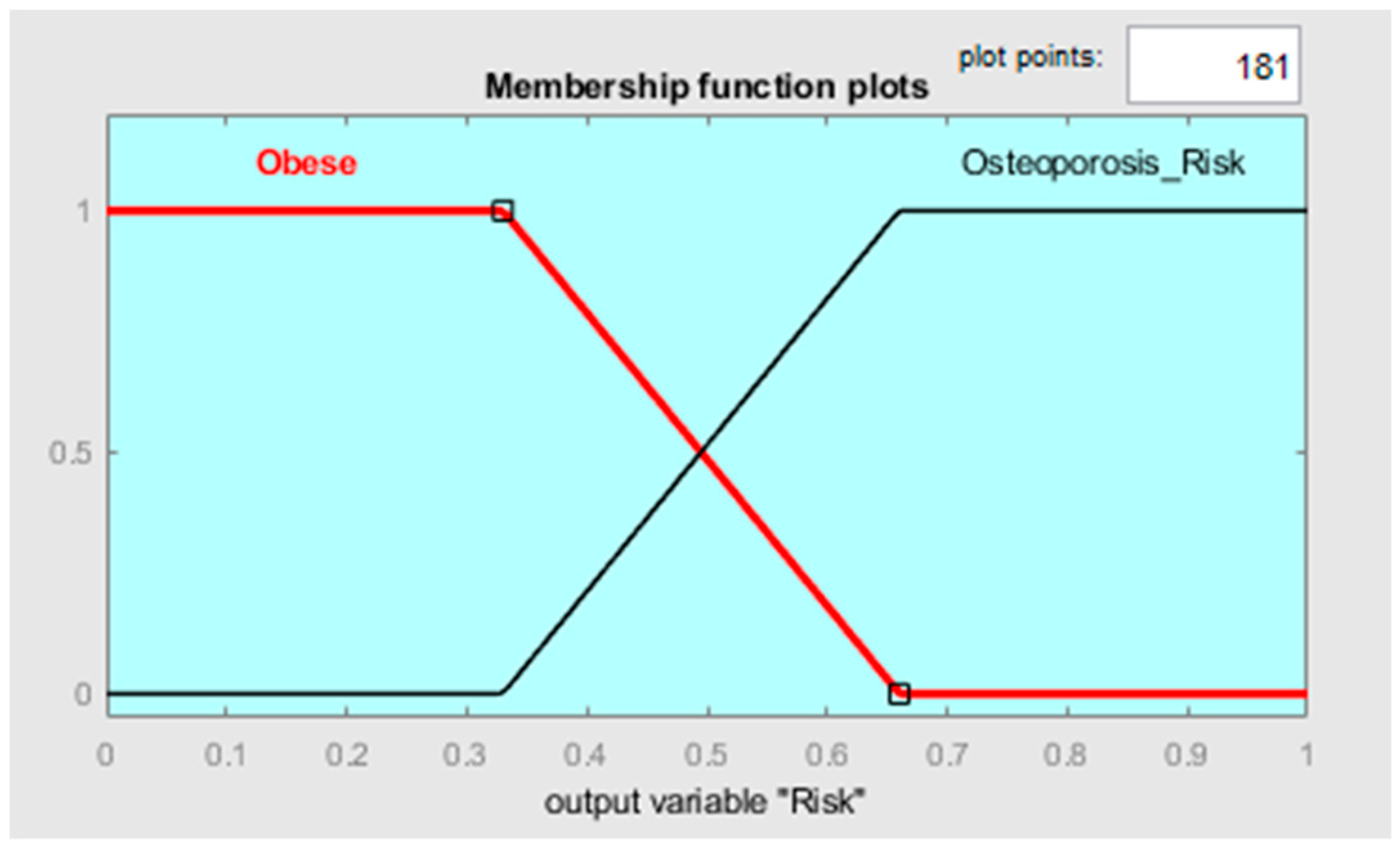

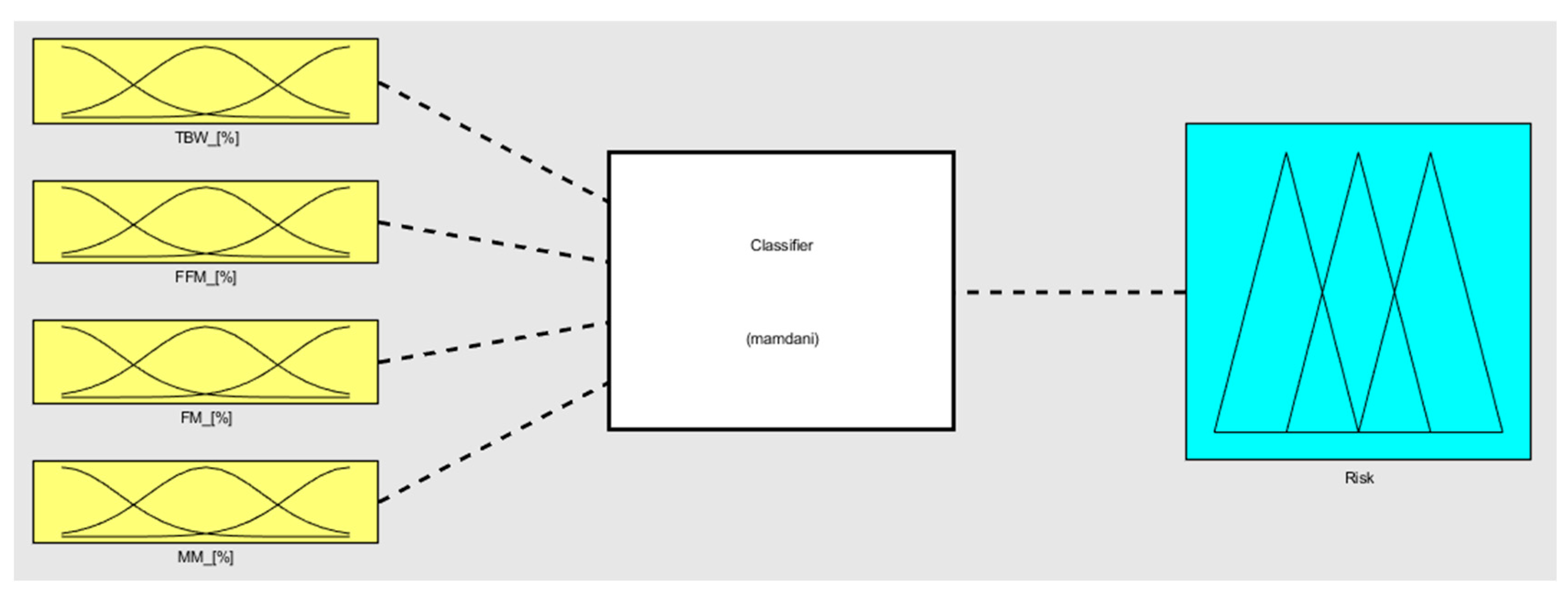
| Metric | Formula |
|---|---|
| Euclidean | |
| Squared Euclidean | |
| Cityblock | |
| Chebyshev | |
| Correlation |
| Linkage Criterion | Formula |
|---|---|
| Single | |
| Complete | |
| Average | |
| Centroid |
| Metric | |||||
|---|---|---|---|---|---|
| Linkage Criterion | Euclidean | Squared Euclidean | Cityblock | Chebychev | Correlation |
| Single | 2 Clusters (Clustering 1) | 2 Clusters (Clustering 1) | 2 Clusters (Clustering 1) | 2 Clusters (Clustering 2) | 2 Clusters (Clustering 2) |
| Complete | 4 Clusters (Clustering 1) | 4 Clusters (Clustering 1) | 8 Clusters | 4 Clusters (Clustering 2) | 3 Clusters (Clustering 3) |
| Average | 2 Clusters (Clustering 1) | 2 Clusters (Clustering 1) | 3 Clusters (Clustering 1) | 4 Clusters (Clustering 3) | 3 Clusters (Clustering 2) |
| Centroid | 2 Clusters (Clustering 1) | 2 Clusters (Clustering 1) | 2 Clusters (Clustering 1) | 4 Clusters (Clustering 4) | 3 Clusters (Clustering 2) |
| Obese Subjects | |
|---|---|
| M/F | 14/32 |
| Age | 48.39 ± 9.01 |
| Height (cm) | 167.80 ± 8.45 |
| Weight (kg) | 86.47 ± 13.57 |
| BMI (kg/m2) | 30.48 ± 3.48 |
| TBW (%) | 49 ± 5.20 |
| FFM (%) | 67 ± 6.90 |
| FM (%) | 33 ± 6.90 |
| MM (%) | 45 ± 6.43 |
| Input Variables | Output Variable | |||||
|---|---|---|---|---|---|---|
| TBW | FFM | FM | MM | Risk | ||
| if | Low | Low | High | Low | then | Osteoporosis |
| if | Normal | Normal | Normal | Normal | then | Low |
| TBW | FFM | FM | MM | Risk | |
|---|---|---|---|---|---|
| Centroid | 49.58 | 67.57 | 32.43 | 45.99 | 0 |
| Closest values No-Risk on Risk | 42 | 57.2 | 42.8 | 38 | 0.2 |
| Centroid | 38.4 | 52.5 | 47.5 | 33.5 | 0.9 |
| 3 percentage points over Risk | 35.4 | 49.5 | 50.5 | 30.5 | 1 |
Disclaimer/Publisher’s Note: The statements, opinions and data contained in all publications are solely those of the individual author(s) and contributor(s) and not of MDPI and/or the editor(s). MDPI and/or the editor(s) disclaim responsibility for any injury to people or property resulting from any ideas, methods, instructions or products referred to in the content. |
© 2023 by the authors. Licensee MDPI, Basel, Switzerland. This article is an open access article distributed under the terms and conditions of the Creative Commons Attribution (CC BY) license (https://creativecommons.org/licenses/by/4.0/).
Share and Cite
Sgarro, G.A.; Grilli, L.; Valenzano, A.A.; Moscatelli, F.; Monacis, D.; Toto, G.; De Maria, A.; Messina, G.; Polito, R. The Role of BIA Analysis in Osteoporosis Risk Development: Hierarchical Clustering Approach. Diagnostics 2023, 13, 2292. https://doi.org/10.3390/diagnostics13132292
Sgarro GA, Grilli L, Valenzano AA, Moscatelli F, Monacis D, Toto G, De Maria A, Messina G, Polito R. The Role of BIA Analysis in Osteoporosis Risk Development: Hierarchical Clustering Approach. Diagnostics. 2023; 13(13):2292. https://doi.org/10.3390/diagnostics13132292
Chicago/Turabian StyleSgarro, Giacinto Angelo, Luca Grilli, Anna Antonia Valenzano, Fiorenzo Moscatelli, Domenico Monacis, Giusi Toto, Antonella De Maria, Giovanni Messina, and Rita Polito. 2023. "The Role of BIA Analysis in Osteoporosis Risk Development: Hierarchical Clustering Approach" Diagnostics 13, no. 13: 2292. https://doi.org/10.3390/diagnostics13132292
APA StyleSgarro, G. A., Grilli, L., Valenzano, A. A., Moscatelli, F., Monacis, D., Toto, G., De Maria, A., Messina, G., & Polito, R. (2023). The Role of BIA Analysis in Osteoporosis Risk Development: Hierarchical Clustering Approach. Diagnostics, 13(13), 2292. https://doi.org/10.3390/diagnostics13132292










